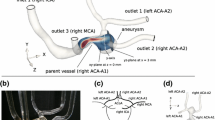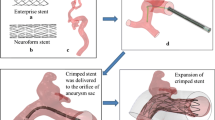Abstract
A flow diverter (FD) is a flexible, densely braided stent-mesh device placed endoluminally across an intracranial aneurysm to induce its thrombotic occlusion. FD treatment planning using computational virtual stenting and flow simulation requires accurate representation of the expanded FD geometry. We have recently developed a high fidelity virtual stenting (HiFiVS) technique based on finite element analysis to simulate detailed FD deployment processes in patient-specific aneurysms (Ma et al. J. Biomech. 45:2256–2263, 2012). This study tests if HiFiVS simulation can recapitulate real-life FD implantation. We deployed two identical FDs (Pipeline Embolization Device) into phantoms of a wide-necked segmental aneurysm using a clinical push–pull technique with different delivery wire advancements. We then simulated these deployment processes using HiFiVS and compared results against experimental recording. Stepwise comparison shows that the simulations precisely reproduced the FD deployment processes recorded in vitro. The local metal coverage rate and pore density quantifications demonstrated that simulations reproduced detailed FD mesh geometry. These results provide validation of the HiFiVS technique, highlighting its unique capability of accurately representing stent intervention in silico.










Similar content being viewed by others
References
Appanaboyina, S., F. Mut, R. Lohner, C. Putman, and J. Cebral. Simulation of intracranial aneurysm stenting: techniques and challenges. Comput. Methods Appl. Mech. Eng. 198:3567–3582, 2009.
Bernardini, A., I. Larrabide, H. G. Morales, G. Pennati, L. Petrini, S. Cito, and A. F. Frangi. Influence of different computational approaches for stent deployment on cerebral aneurysm haemodynamics. Interface Focus 1:338–348, 2011.
Bernardini, A., I. Larrabide, L. Petrini, G. Pennati, E. Flore, M. Kim, and A. F. Frangi. Deployment of self-expandable stents in aneurysmatic cerebral vessels: comparison of different computational approaches for interventional planning. Comput. Methods Biomech. Biomed. Eng. 15:303–311, 2012.
Cebral, J. R., F. Mut, M. Raschi, E. Scrivano, R. Ceratto, P. Lylyk, and C. M. Putman. Aneurysm rupture following treatment with flow-diverting stents: computational hemodynamics analysis of treatment. Am. J. Neuroradiol. 32:27–33, 2011.
De Beule, M., S. Van Cauter, P. Mortier, D. Van Loo, R. Van Impe, P. Verdonck, and B. Verhegghe. Virtual optimization of self-expandable braided wire stents. Med. Eng. Phys. 31:448–453, 2009.
Fischer, S., Z. Vajda, M. Aguilar Perez, E. Schmid, N. Hopf, H. Bazner, and H. Henkes. Pipeline embolization device (PED) for neurovascular reconstruction: initial experience in the treatment of 101 intracranial aneurysms and dissections. Neuroradiology 54:369–382, 2012.
Fu, W., Z. Gu, X. Meng, B. Chu, and A. Qiao. Numerical simulation of hemodynamics in stented internal carotid aneurysm based on patient-specific model. J. Biomech. 43:1337–1342, 2010.
Hoi, Y., S. H. Woodward, M. Kim, D. B. Taulbee, and H. Meng. Validation of CFD simulations of cerebral aneurysms with implication of geometric variations. J. Biomech. Eng. Trans. ASME 128:844–851, 2006.
Janiga, G., C. Rossl, M. Skalej, and D. Thevenin. Realistic virtual intracranial stenting and computational fluid dynamics for treatment analysis. J. Biomech. 46:7–12, 2013.
Jedwab, M. R., and C. O. Clerc. A study of the geometrical and mechanical properties of a self-expanding metallic stent—theory and experiment. J. Appl. Biomater. 4:77–85, 1993.
Kallmes, D. F., Y. H. Ding, D. Dai, R. Kadirvel, D. A. Lewis, and H. J. Cloft. A new endoluminal, flow-disrupting device for treatment of saccular aneurysms. Stroke 38:2346–2352, 2007.
Kan, P., A. H. Siddiqui, E. Veznedaroglu, K. M. Liebman, M. J. Binning, T. M. Dumont, C. S. Ogilvy, J. R. Gaughen, Jr., J. Mocco, G. J. Velat, A. J. Ringer, B. G. Welch, M. B. Horowitz, K. V. Snyder, L. N. Hopkins, and E. I. Levy. Early postmarket results after treatment of intracranial aneurysms with the Pipeline Embolization Device: a U.S. multicenter experience. Neurosurgery 71:1080–1087; discussion 1087–1088, 2012.
Kim, J. H., T. J. Kang, and W. R. Yu. Mechanical modeling of self-expandable stent fabricated using braiding technology. J. Biomech. 41:3202–3212, 2008.
Kosukegawa, H., K. Mamada, L. Liu, K. Inoue, K. Kuroki, T. Havase, and M. Ohta. Measurements of dynamic viscoelasticity of poly (vinyl alcohol) hydrogel for the development of blood vessel biomodeling. J. Fluid Sci. Technol. 3:533–543, 2008.
Kosukegawa, H., S. Shida, Y. Hashida, and M. Ohta. Mechanical properties of tube-shaped poly (vinyl alcohol) hydrogel blood vessel biomodel. ASME 2010 3rd Joint US-European Fluids Engineering Summer Meeting and 8th International Conference on Nanochannels, Microchannels, and Minichannels. 2010.
Kulcsár, Z., L. Augsburger, P. Reymond, V. M. Pereira, S. Hirsch, A. S. Mallik, J. Millar, S. G. Wetzel, I. Wanke, and D. A. Rüfenacht. Flow diversion treatment: intra-aneurismal blood flow velocity and WSS reduction are parameters to predict aneurysm thrombosis. Acta Neurochir. 154:1827–1834, 2012.
Larrabide, I., M. Kim, L. Augsburger, M. C. Villa-Uriol, D. Rüfenacht, and A. F. Frangi. Fast virtual deployment of self-expandable stents: method and in vitro evaluation for intracranial aneurysmal stenting. Med. Image Anal. 16:721–730, 2012.
Lieber, B. B., and C. Sadasivan. Endoluminal scaffolds for vascular reconstruction and exclusion of aneurysms from the cerebral circulation. Stroke 41:S21–S25, 2010.
Lylyk, P., C. Miranda, R. Ceratto, A. Ferrario, E. Scrivano, H. R. Luna, A. L. Berez, Q. Tran, P. K. Nelson, and D. Fiorella. Curative endovascular reconstruction of cerebral aneurysms with the pipeline embolization device: the Buenos Aires experience. Neurosurgery 64:632–642, 2009.
Ma, D., G. F. Dargush, S. K. Natarajan, E. I. Levy, A. H. Siddiqui, and H. Meng. Computer modeling of deployment and mechanical expansion of neurovascular flow diverter in patient-specific intracranial aneurysms. J. Biomech. 45:2256–2263, 2012.
Makoyeva, A., F. Bing, T. E. Darsaut, I. Salazkin, and J. Raymond. The varying porosity of braided self-expanding stents and flow diverters: an experimental study. Am. J. Neuroradiol. 34:596–602, 2013.
Nelson, P. K., P. Lylyk, I. Szikora, S. G. Wetzel, I. Wanke, and D. Fiorella. The pipeline embolization device for the intracranial treatment of aneurysms trial. Am. J. Neuroradiol. 32:34–40, 2011.
Ohta, M., A. Handa, and H. Iwata. Poly-vinyl alcohol hydrogel vascular models for in vitro aneurysm simulations: the key to low friction surfaces. Technol. Health Care 12:225–233, 2004.
Shirasu, K., N. Wakabayashi, T. Yoneyama, and Y. Igarashi. Non-linear finite element stress analysis of plastic deformation in Co-Cr wrought-wire clasps. Dent. Mater. 24:1518–1524, 2008.
Siddiqui, A. H., A. A. Abla, P. Kan, T. M. Dumont, S. Jahshan, G. W. Britz, L. N. Hopkins, and E. I. Levy. Panacea or problem: flow diverters in the treatment of symptomatic large or giant fusiform vertebrobasilar aneurysms. J. Neurosurg. 116:1258–1266, 2012.
Siddiqui, A. H., P. Kan, A. A. Abla, L. N. Hopkins, and E. I. Levy. Complications after treatment with Pipeline embolization for giant distal intracranial aneurysms with or without coil embolization. Neurosurgery. 71:E509–E513; discussion E513, 2012.
Szikora, I., Z. Berentei, Z. Kulcsar, M. Marosfoi, Z. S. Vajda, W. Lee, A. Berez, and P. K. Nelson. Treatment of intracranial aneurysms by functional reconstruction of the parent artery: the Budapest experience with the pipeline embolization device. Am. J. Neuroradiol. 31:1139–1147, 2010.
Tremmel, M., J. Xiang, S. K. Natarajan, L. N. Hopkins, A. H. Siddiqui, E. I. Levy, and H. Meng. Alteration of intra-aneurysmal hemodynamics for flow diversion using enterprise and vision stents. World Neurosurg. 74:306–315, 2010.
Tse, M. M., B. Yan, R. J. Dowling, and P. J. Mitchell. Current status of Pipeline Embolization Device in the treatment of intracranial aneurysms: A review. World Neurosurg. 2013. doi:10.1016/j.wneu.2012.09.023.
Wu, W., M. Qi, X. P. Liu, D. Z. Yang, and W. Q. Wang. Delivery and release of nitinol stent in carotid artery and their interactions: a finite element analysis. J. Biomech. 40:3034–3040, 2007.
Xu, Z., N. Chen, S. C. Shadden, J. E. Marsden, M. M. Kamocka, E. D. Rosen, and M. Alber. Study of blood flow impact on growth of thrombi using a multiscale model. Soft Matter 5:769–779, 2009.
Zhang, Y., X. Yang, S. Wang, A. Qiao, J. Chen, K. Zhang, Z. Liu, Y. Zhao, Y. Zhang, B. Luo, and C. Li. Hemodynamic effects of stenting on wide-necked intracranial aneurysms. Chin. Med. J. (Engl.) 123:1999–2003, 2010.
Acknowledgments
This study was partially supported by NIH/NINDS (Grant No. R01NS064592), Toshiba Medical Systems, Covidien (Grant No. VTGCC053012-009), and National Science Foundation of China (Grant No. 81220108007 and 81171079). We thank Dr. Jianping Xiang for assistance in phantom fabrication, Dr. Robert Baier for surface analysis of FD strands, Lisa Pope and Michael Rejewski for assistance on in vitro experiment, and Nicholas Liaw for editorial assistance.
Conflict of interest
The authors Ma, Dumont, Kosukegawa, Ohta, and Yang have no conflict of interest. Meng—Principal investigator of NIH/NINDS Grant R01NS064592. Siddiqui—Research Grants–NIH (co-investigator: NINDS 1R01NS064592-01A1), University at Buffalo (Research Development Award); financial interests–Hotspur, Intratech Medical, StimSox, Valor Medical; consultant to Codman & Shurtleff, Concentric Medical, ev3/Covidien Vascular Therapies, GuidePoint Global Consulting, Penumbra; speakers’ bureaus—Codman & Shurtleff, Genentech; advisory board–Codman & Shurtleff; honoraria–Abbott Vascular, Codman & Shurtleff, Genentech, Neocure Group LLC.
Author information
Authors and Affiliations
Corresponding author
Additional information
Associate Editor Jane Grande-Allen oversaw the review of this article.
Rights and permissions
About this article
Cite this article
Ma, D., Dumont, T.M., Kosukegawa, H. et al. High Fidelity Virtual Stenting (HiFiVS) for Intracranial Aneurysm Flow Diversion: In Vitro and In Silico . Ann Biomed Eng 41, 2143–2156 (2013). https://doi.org/10.1007/s10439-013-0808-4
Received:
Accepted:
Published:
Issue Date:
DOI: https://doi.org/10.1007/s10439-013-0808-4




